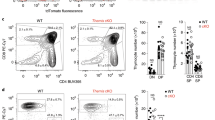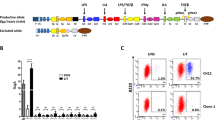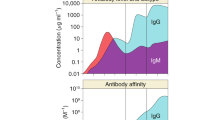Abstract
CLASS II major histocompatibility complex (MHC) molecules function as antigen-presenting elements as well as signal transducers on B lymphocytes. We previously reported that a B lym-phoma cell transfectant, 5C2, expressing genetically engineered I-Ak molecules with truncated cytoplasmic domains was severely impaired in both antigen presentation and in anti-Ia-induced intracytoplasmic signalling1–5. These two functions could be restored by preculturing 5C2 cells with cyclic AMP analogues6,7. Here we demonstrate that impaired signal transduction by truncated class II molecules results in a deficiency in induction of the newly defined B-cell accessory molecule B7 (ref. 8), which can be reversed by restoration of B7 expression. These data imply that contact of the T-cell antigen receptor with MHC/antigen ligand results in signal transmission through the class II cytoplasmic domain. This signal, which can be mimicked by dibutyryl cAMP, induces expression of B7, resulting in effective antigen presentation. The fact that crosslinking of surface class II MHC also induces B7 expression on normal resting human B cells9 supports this contention.
This is a preview of subscription content, access via your institution
Access options
Subscribe to this journal
Receive 51 print issues and online access
$199.00 per year
only $3.90 per issue
Buy this article
- Purchase on Springer Link
- Instant access to full article PDF
Prices may be subject to local taxes which are calculated during checkout
Similar content being viewed by others
References
Nabavi, N. et al. J. Immun. 142, 1444–1447 (1989).
Cambier, J. C. et al. Nature 327, 629–632 (1987).
Wade, W. F. et al. Proc. natn. Acad. Sci. U.S.A. 86, 6297–6301 (1989).
Pollok, K. E. et al. J. Immun. 146, 1633–1641 (1991).
Chen, Z. Z., McGuire, J. C., Leach, K. L. & Cambier, J. C. J. Immun. 138, 2345–2352 (1987).
St.-Pierre, Y., Nabavi, N., Ghogawala, Z., Glimcher, L. H. & Watts, T. H. J. Immun. 143, 808–812 (1989).
St.-Pierre, Y. & Watts, T. H. J. Immun. 147, 2875–2882 (1991).
June, C. H., Ledbetter, J. A., Linsley, P. S. & Thompson, C. B. Immun. Today 11, 211–216 (1990).
Koulova, L., Clark, E. A., Shu, G. & Dupont, B. J. exp. Med. 173, 759–762 (1991).
Freeman, G. J. et al. J. exp. Med. 174, 625–631 (1991).
Freedman, A. S., Freeman, G. J., Rhynhart, K. & Nadler, L. M. Cell Immun. 137, 429–437 (1991).
Yokochi, T., Holly, R. D. & Clark, E. A. J. Immun. 128, 823–827 (1982).
Freedman, A. S., Freeman, G., Horowitz, J. C., Daley, J. & Nadler, L. M. J. Immun. 139, 3260–3267 (1987).
Linsley, P. S. et al. J. exp. Med. 173, 721–730 (1991).
Linsley, P. S. et al. J. exp. Med. 174, 561–569 (1991).
Linsley, P. S., Clark, E. A. & Ledbetter, J. A. Proc. natn. Acad. Sci. U.S.A. 87, 5031–5035 (1990).
Gimmi, C. D. et al. Proc. natn. Acad. Sci. U.S.A. 88, 6575–6579 (1991).
Damle, N. K., Linsley, P. S. & Ledbetter, J. A. Eur. J. Immun. 21, 1277–1281 (1991).
Reiser, H. et al. Proc. natn. Acad. Sci. U.S.A. 89, 271–275 (1992).
Marrack, P. et al. J. exp. Med. 158, 1077–1091 (1983).
Author information
Authors and Affiliations
Rights and permissions
About this article
Cite this article
Nabavi, N., Freeman, G., Gault, A. et al. Signalling through the MHC class II cytoplasmic domain is required for antigen presentation and induces B7 expression. Nature 360, 266–268 (1992). https://doi.org/10.1038/360266a0
Received:
Accepted:
Issue Date:
DOI: https://doi.org/10.1038/360266a0
This article is cited by
-
Antibodies to HLA Molecules Mimic Agonistic Stimulation to Trigger Vascular Cell Changes and Induce Allograft Injury
Current Transplantation Reports (2015)
-
Class II, major histocompatibility complex, transactivator (CIITA) in channel catfish: identification and expression patterns responding to different pathogens
Molecular Biology Reports (2012)
-
Association between the Cytotoxic T-Lymphocyte Antigen 4 +49G > A polymorphism and cancer risk: a meta-analysis
BMC Cancer (2010)
-
Open reading frame sequencing and structure-based alignment of polypeptides encoded by RT1-Bb, RT1-Ba, RT1-Db, and RT1-Da alleles
Immunogenetics (2004)
-
Concurrent induction of T-cell activation and apoptosis of osteosarcoma cells by adenovirus-mediated B7-1/Fas chimeric gene transfer
Cancer Gene Therapy (2003)
Comments
By submitting a comment you agree to abide by our Terms and Community Guidelines. If you find something abusive or that does not comply with our terms or guidelines please flag it as inappropriate.



